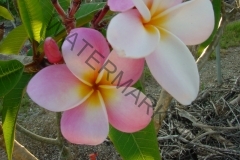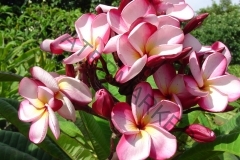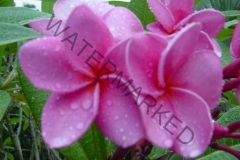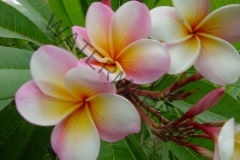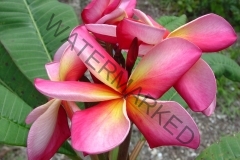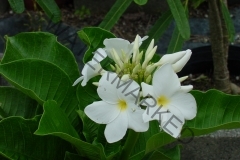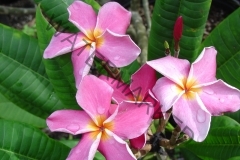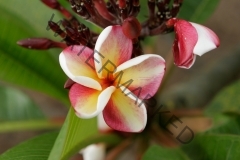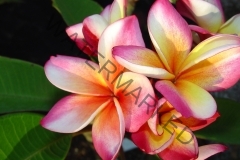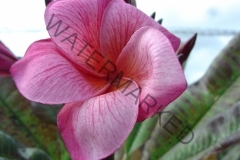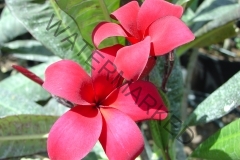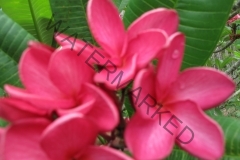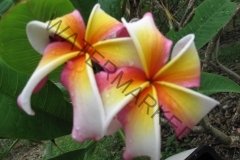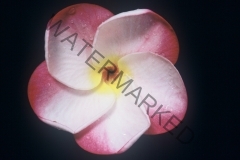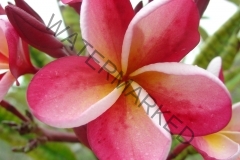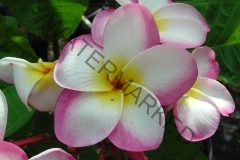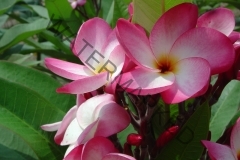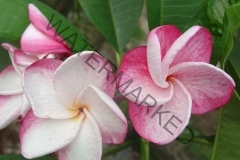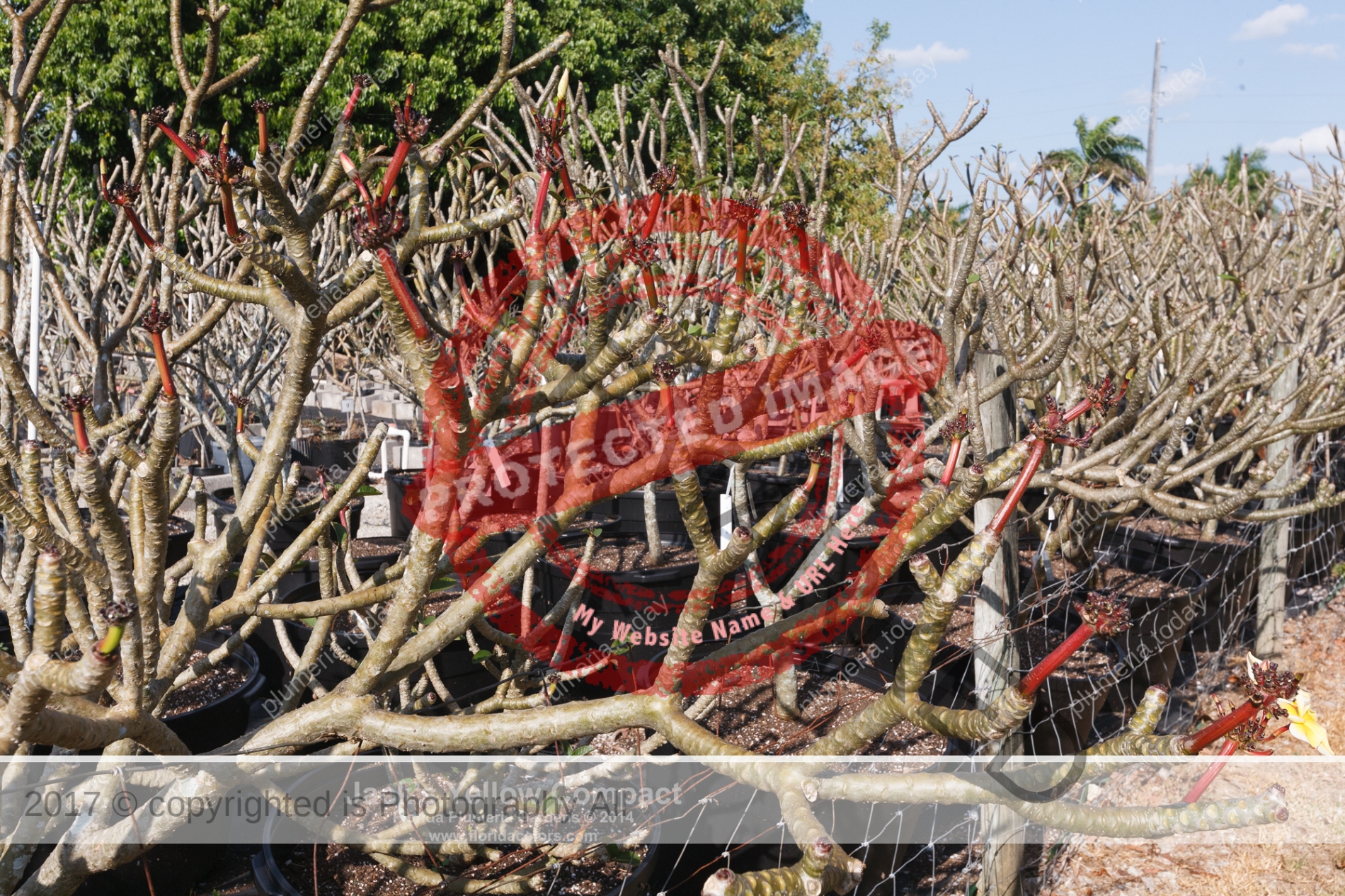Propagation by cuttings is the most commonly used method to propagate plumeria, a cutting will produce an exact clone of the parent plant. Normally plumeria cuttings are quite easy to root if done in the Spring and Summer. All plumeria cuttings will root under perfect conditions, some take longer than others. Do your research so you are aware of the hard to root cultivars. Some hybrid plumeria can be more difficult to root.
The most common mistakes are over watering and trying to root late in the growing season. For difficult to root plumeria cuttings you can use a grow or heat mat placed under the pots to encourage new root growth. Plumeria roots grow best when the root zone temperature is between 75 and 85 degrees.
The fertility status of the donor plant can influence rooting. Avoid taking cuttings from plants that show symptoms of mineral nutrient deficiency. Conversely, plants that have been fertilized heavily, particularly with nitrogen, may not root well. The stock plant should not be under moisture stress. Cuttings from lateral shoots often root better than cuttings from terminal shoots.
There are many good methods developed for starting cuttings. You can find some good articles on cuttings with various methods on Plumeria.Care. Which one works best for you will depend on the time of year and your climate.
Rooting Plumeria Cuttings in Soil
Below is a guide to start your plumeria from cuttings. What are Plumeria Cuttings, Rooted Plumeria and Grafted Plumeria.
- When to take cuttings? Although you will eventually wind up with broken branches at different times of the year, the time of the year is important to your cutting survival chances. Different regions have different length of growing season.
- Spring is the best time to start plumeria cuttings, when the are waking up from dormancy.
- Early to Mid Summer is also good time. Late summer is ok. The later you start a cutting the less chance you have to correct problems you may have.
- Early Fall or later does not give your cutting a chance to put on a good root system to survive the first winter unless you extended the growing season with lights and bottom heat.
- When taking cuttings it is important to decide the reason you are taking the cuttings.
- Will you root the cutting yourself?
- Will you graft the cutting?
- Preparing the donor Plumeria tree for taking cuttings
- Selecting a healthy tree with no visible signs of stress is important, the healthier the donor tree, the better survival chances your cutting will have.
- Watering the donor tree the night before will provide extra hydration to the cutting.
- Remove the leaves by cutting the leaf stem about 1/2″ from the branch before or right after you take the cutting. Leaves left on cuttings will cause the loss of valuable moisture. Breaking the leaves off can damage the cutting and allow disease to enter at the damaged leaf nodes.
- If taking the cutting for rooting remove any inflorescence, they could prevent the cutting from rooting.
- Take cuttings from plumeria using clean tools. You can use garden shears, a sharp knife or saw with fine teeth.
- Clean your cutting tools between taking cuttings from each tree or even more often.
- Do not cut bad branches off when taking cuttings.
- Select a branch from the last growing season that is light gray for best results.
- For rooting, cuttings should be 12″ or longer. Larger cuttings have a better chance of rooting, but I’ve noticed that very large branches take longer to root.
- For grafting, cuttings should be 8″ to 12″ long. Large cuttings are more difficult to handle and slip more easily. Finding the right root stock can be a problem for large diameter cuttings.
- Right after you make the cuttings.
- For rooting, dip in a rooting hormone, the longer you wait the less benefit it will have.
- For grafting no need to dip in a rooting hormone.
- Allow the cuttings to Callus. Roots will not form until the cutting has formed callus.
- Place in a warm dry place out of direct sun.
- Allow plenty of air circulation.
- Check the cut ends often to be sure they are not getting soft. If you find any getting soft, you should cut until you see good white wood.
- Allow the cuttings to dry until the cut end is hard, usually from 1 week in warm climates to 2 weeks or longer in cooler climates.
- Cuttings can be stored for weeks or even months, depending on the cultivar. The sooner they are planted after properly callused, the better they will do.
- Potting soil mix preparation
- Use a mixture of 1 parts Perlite to 1 part potting mix without fertilizer. The key is to have a well draining mix.
- Moisten the potting mixture until it holds together but is not dripping water.
- Fill a rooting tube or 1 gal pot (larger if needed for big cuttings) with lots of drain holes with the potting mix.
- Use one pot for each cutting
- Or one rooting tube for each cutting
- If using rooting tubes, place a cotton ball in the bottom so you will not lose soil.
- You can use a large pot and place several in 1 pot. This is called gang rooting. It works well, but can cause damage to the roots when transplanting.
- Make a hole 3″ to 5” deep deep and a little bigger than the diameter of your cuttings in the center of each pot.
- Use your finger or the handle of a trowel.
- Insert the cutting in the hole.
- Gently firm the soil around the cutting.
- It is a good idea to use bamboo stakes to keep the cutting from moving. The slightest movement for wind or animals could break the newly formed roots.
- Watering you newly planted cutting
- Water the pot or rooting tube well ONCE with a mix of Vitazyme and Carl Pool’s Root Activator and do not water again until you see 3 or 4 full leaves.
- Add more soil if needed.
- Check the cuttings every week.
- If the cutting seems to get dehydrated or shows wrinkles, then you should lightly mist every day until the wrinkles are gone or at least minimized (NOT WATER)
- Watering a rooting cutting to much will cause rot.
- Place your potted cutting in a warm location and move to full sun after a week or so of exposing it to more sun each day.
- When your cutting has 3 to 4 full sized leaves your cutting typically will have roots. The more the leaves the more roots.
- Depending on your location and weather, cutting will form good roots in about 45 days.
- The reds are usually harder to root.
- Fertilizing by misting the new leaves is a good idea. Use 1/2 strength for first time and spray early or late in the day, but not in full sun.
- Transplanting
- Your cutting can stay in a 1 gal pot for many months. You can transplant to a larger pot when you see roots coming out of the pot.
- If in a Rooting tube, you should transplant when you see 4-6 leaves to a pot.
- Or you can transplant into the ground if you are in an area free of frost or freezes.
Tips
- Cuttings should generally consist of the current or past season’s growth. Avoid taking green cuttings, they are harder to root and avoid material with flower buds if possible. Remove any flowers and flower buds when preparing cuttings so the cutting’s energy can be used in producing new roots rather than flowers. Take cuttings from healthy, disease-free plants, preferably from the upper part of the plant. Select cuttings from a healthy plumeria.
- If your cutting looks wrinkled, soak overnight in warm water. Add a little SuperThrive (follow mix instructions) or Hydrogen Peroxide (use 1/2 cup to 1 gal).
- If you cutting starts to get soft and turns black on the cut end, you should cut until you see all white.
- If your cutting is already hard on the cut end, you do not need to recut.
- DO NOT use a bloom booster fertilizer (high center number), you want the cutting’s energy going towards creating roots, not to producing blooms.
- Newly rooted cuttings should not be transplanted directly into the landscape. Instead, transplant them into containers. Growing them to a larger size before transplanting to a permanent location will increase the chances for survival.
- Rooting time varies with the type of cutting (tip or mid cutting), the cultivar being rooted, and environmental conditions. Reds typically require more time than white or yellow plants. Early Spring to Mid Summer is a good time to root plumeria. Once rooted, they will have three or four normal sized leaves and may be transferred to a larger pot and fertilized. Winter is not a good time due to plumeria going dormant.
- The rooting medium should be sterile, low in fertility, and well-drained to provide sufficient aeration. It should also retain enough moisture so that watering does not have to be done too frequently. Materials commonly used is a mixture of one part peat and one part perlite (by volume). Vermiculite by itself is not recommended, because it compacts and tends to hold too much moisture. Media should be watered while being used.
- Place the cutting out of direct sun in a dry location. Allow the cut end of the cutting to dry until it is dry and firm. This takes 5 to 15 days depending on the weather. If the cut end becomes soft or rot starts, you will need to cut until all the dark coloration is gone. You can dip in a rooting hormone after a new cut is made. Before planting be sure the cutting is firm and looks healthy. If the cutting looks dehydrated or wrinkled you can soak for 4-6 hours in water. A bit of SuperThrive can be beneficial.
- Treating cuttings with root-promoting compounds, (while the latex is still wet) can be a valuable tool in stimulating rooting of some plumeria that might otherwise be difficult to root. Prevent possible contamination of the entire supply of rooting hormone by putting some in a separate container before treating cuttings. Any material that remains after treatment should be discarded and not returned to the original container. Be sure to tap the cuttings to remove excess hormone when using a powder formulation.
- While terminal parts of the stem are best, a long shoot can be divided into several cuttings. Depending on the Cultivar cuttings will generally range from 10 to 18 inches long. Use a sharp, thin-bladed pocket knife or sharp pruning shears. If necessary, dip the cutting tool in rubbing alcohol or a mixture of 1 part bleach to 9 parts water to prevent transmitting diseases from infected plant parts to healthy ones.
Supplies You’ll Need
- Clean and sharp shears or knife
- Isopropyl Alcohol, for cleaning tools
- Hydrogen Peroxide, Why Hydrogen Peroxide or SuperThrive
- 1 gal or 2 gal nursery pots or Rooting Tubes
- Rooting Hormone powder. I suggest Hormodin 2 Rooting Compound for wood and semi-woody plants
- Potting soil
- Coarse Perlite
- Bamboo stakes
- Vitazyme, Why Vitazyme?
- Carl Pool’s Root Activator, Why Carl Pool’s Root Activator?
- A good balanced slow release fertilizer to feed the roots. I suggest Excalibur 11-11-13, Why Excalibur 11-11-13?
- A good balanced fertilizer for Foliar feeding. I suggest BioBlast 7-7-7, Why Bioblast 7-7-7?
Rooting Plumeria cuttings in water
Although people have been rooting plumeria in water with some success, this is not the best way to root your plumeria. The roots that form in water are not the same as roots that form in soil. They are fragile and brittle, adapted to growing in water as opposed to soil. Once you transfer a water-rooted plant to soil, many of these roots will break off immediately and the rest will shrivel and die up as they’re replaced by the more robust roots adapted to soil.
If you do water root, Just remember once a plant is in water, it will develop “water roots” and feed itself with water nutrients. When you put it in soil, (after all that is where they grow naturally) the first week, keep it in a cup, so the soil is really wet, puddle like, then gradually as the weeks go by, decrease the water and just let the soil be moist.
That way, it eventually will send out new soil roots, and can feed itself accordingly.
